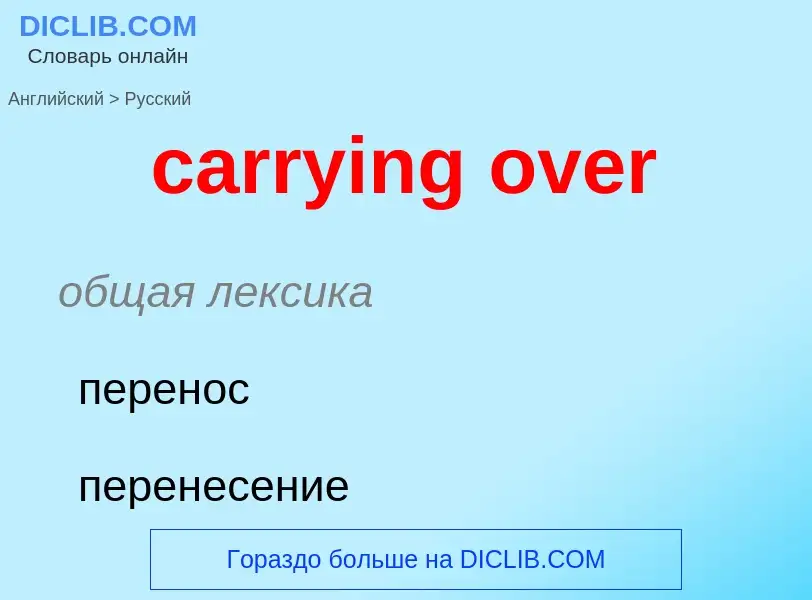Перевод и анализ слов искусственным интеллектом ChatGPT
На этой странице Вы можете получить подробный анализ слова или словосочетания, произведенный с помощью лучшей на сегодняшний день технологии искусственного интеллекта:
- как употребляется слово
- частота употребления
- используется оно чаще в устной или письменной речи
- варианты перевода слова
- примеры употребления (несколько фраз с переводом)
- этимология
carrying over - перевод на русский
общая лексика
перенос
перенесение
2) пропускная способность
3) кормовая продуктивность (пастбища)
4) см. population carrying capacity
['kæriiŋkə'pæsiti]
общая лексика
переносимый объём (максимальная плотность популяции, которая может длительно поддерживаться саморегуляцией)
производительность
кормовая продуктивность (напр. фитоценоза)
пропускная способность
грузоподъёмность
несущая способность
электротехника
допускаемая сила тока
строительное дело
пропускная способность (трубопровода)
нефтегазовая промышленность
грузоподъёмность (трубодержателя для обсадных труб)
бухгалтерский учет
издержки владения (затраты, связанные с владением каким-л. активом (напр. недвижимостью и т. п.); включают налоги на данный актив, расходы по его страхованию, поддержанию в надлежащем порядке и т. п.)
строительное дело
текущие расходы (издержки)
Определение
Википедия
The carrying capacity of an environment is the maximum population size of a biological species that can be sustained by that specific environment, given the food, habitat, water, and other resources available. The carrying capacity is defined as the environment's maximal load, which in population ecology corresponds to the population equilibrium, when the number of deaths in a population equals the number of births (as well as immigration and emigration). The effect of carrying capacity on population dynamics is modelled with a logistic function. Carrying capacity is applied to the maximum population an environment can support in ecology, agriculture and fisheries. The term carrying capacity has been applied to a few different processes in the past before finally being applied to population limits in the 1950s. The notion of carrying capacity for humans is covered by the notion of sustainable population.
At the global scale, scientific data indicates that humans are living beyond the carrying capacity of planet Earth and that this cannot continue indefinitely. This scientific evidence comes from many sources. It was presented in detail in the Millennium Ecosystem Assessment of 2005, a collaborative effort involving more than 1,360 experts worldwide. More recent, detailed accounts are provided by ecological footprint accounting, and interdisciplinary research on planetary boundaries to safe human use of the biosphere. The Sixth Assessment Report on Climate Change from the IPCC and the First Assessment Report on Biodiversity and Ecosystem Services by the IPBES, large international summaries of the state of scientific knowledge regarding climate disruption and biodiversity loss, also support this view.
An early detailed examination of global limits was published in the 1972 book Limits to Growth, which has prompted follow-up commentary and analysis. A 2012 review in Nature by 22 international researchers expressed concerns that the Earth may be "approaching a state shift" in which the biosphere may become less hospitable to human life and in which human carrying capacity may diminish. This concern that humanity may be passing beyond "tipping points" for safe use of the biosphere has increased in subsequent years. Recent estimates of Earth's carrying capacity run between two to four billion people, depending on how optimistic researchers are about international cooperation to solve collective action problems. These estimates affirm that the more people we seek to sustain, the more modest their average standard of living needs to be.


![A fishery at sunset in Cochin, Kerala, [[India]]. A fishery at sunset in Cochin, Kerala, [[India]].](https://commons.wikimedia.org/wiki/Special:FilePath/Sunset Fishery, Cochin, Kerala, India.jpg?width=200)
![Summering]] of milk cows in the Swiss Alps in [[Valais]] Canton Summering]] of milk cows in the Swiss Alps in [[Valais]] Canton](https://commons.wikimedia.org/wiki/Special:FilePath/Sömmerung von Milchkühen, Schweizer Alp im Wallis.jpg?width=200)
